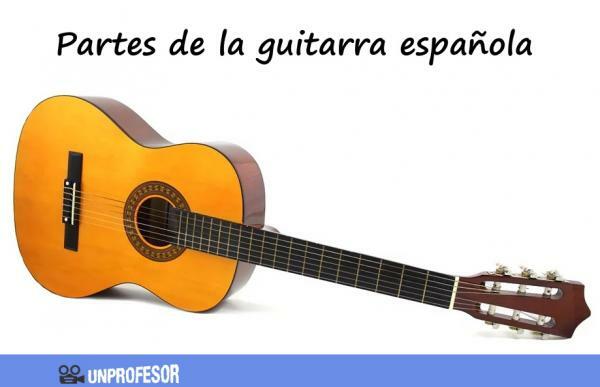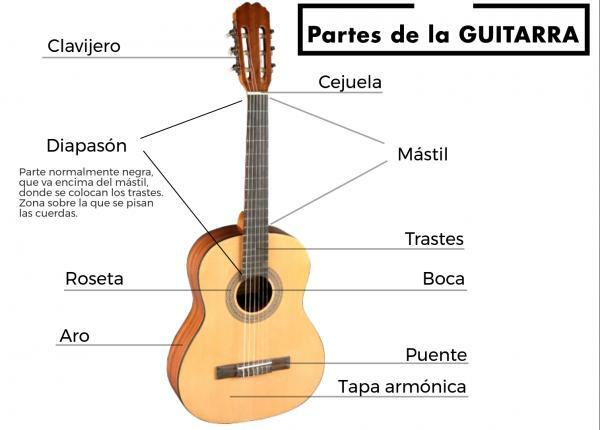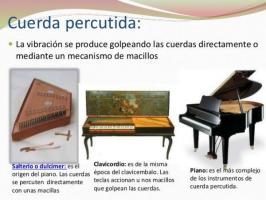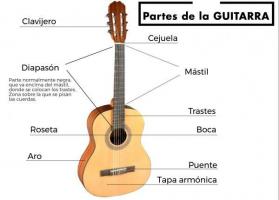All the PARTS of the Spanish GUITAR

In the world of music there is a incredible variety of instruments. Each of them has unique characteristics that consequently give us special sounds and bells. Throughout history, several versions of the same instrument have been developed, its shape, its parts or materials have evolved and changed responding to the taste and ideas of the epoch. Some instruments have been so successful in creating wonderful sounds that they are here to stay. In this lesson from a TEACHER we will talk about one of these instruments: we will know the parts of the Spanish guitar.
The guitar is a plucked string instrument portable (easy to transport), generally with a body made of wood thanks to its resonance quality and it has strings that are played with the fingers of one hand. The strings are pressed with the other hand to change the pitch to the desired notes.
There are several versions of a guitar, but one of the most used is the Spanish guitar or classical guitar, which refers to the 6 string guitar (The first 3 are highest in nylon and the rest are wound with metal), with a wooden body with its own resonance box and with 19 frets on the neck in its standard version. This is the guitar that is used to interpret classical music.
Although the first appearance of this version of the instrument is unknown exactly and its origins oldest come from the Middle East, it is estimated that the Spanish guitar was called as such in the sixteenth century, when several works were written for the instrument and became popular in Spain.
Guitar performance
The guitar is played with both hands simultaneously, one hand plucks the strings and the other presses them to change their pitch. This sound travels to the resonance box through a hole in the center. The strings are of different thicknesses and are taut on both sides.

Image: Slideshare
Let's get to know all the parts of the Spanish guitar to better understand how it works. string instrument which is so popular in our society. The parts of the Spanish guitar are:
Strings
They are 6 and they are the part of the instrument that produces the sound when played with the fingertips. These are tensioned at both ends and are of different thickness to produce higher or lower notes. As we mentioned, the first 3 strings are made of nylon and the rest are metallic, wound with copper (generally).
Sounding board
It is the body of the instrument and the largest part, it is made of wood. This is the space that sound enters to resonate and amplify. The front of the body is called soundboard, to the rear, background, and to the curved piece that joins them on the sides: ring. The soundboard can vary somewhat in its measurements and curvature, but it is always shaped like an hourglass, with the top slightly smaller than the bottom.
Inside, the soundboard has smaller pieces of wood that support its structure and the timbre of the sound, they are different: spinet, hoops and counterbands.
Mouth
Another part of the Spanish guitar is the mouth. This is the name given to the hole in the middle of the instrument through which the sound enters the resonance box. The mouth has a traditional ornament on its periphery that is called rosette and its design varies.
Mast
It is the piece attached from the top to the body of the instrument and the one with the frets. This specific part is called diapason. The strings are pressed against the fretboard to produce different notes. At its upper end is the pegbox.
Frets
They are the divisions that the neck has to differentiate the spaces where the strings are pressed to create the different notes. They are generally metallic. The Spanish guitar traditionally has 19 frets. Sometimes some frets are marked with ornaments to facilitate their location relative to their number (example: a dot on the fifth fret).
Pegs
They are the pieces that allow you to tighten or loosen the strings when you turn them. There is a peg for each string so you can tune them independently. The place where the pegs meet is called pegboxand is separated from the neck by a thin piece called capo, which delimits the beginning of the frets.
Bridge
The bridge is another part of the Spanish guitar. It is the piece at the lowest end of the strings where they are attached. Another piece is responsible for separating the strings from the body of the instrument so that they can vibrate, we call this saddle.
Neck
It is located at the junction between the neck and the guitar body, at the rear. It is a piece of wood that provides support and solidity in straightness to the neck.
The Spanish guitar is one of the more versatile instruments thanks to its sweet sound, and the ability to create chords and melodies. It is also a practical instrument because they come in all price ranges and it is very easy to transport. If learning to play guitar catches your eye, it's a good way to get closer to music.

Image: The Spanish guitar



